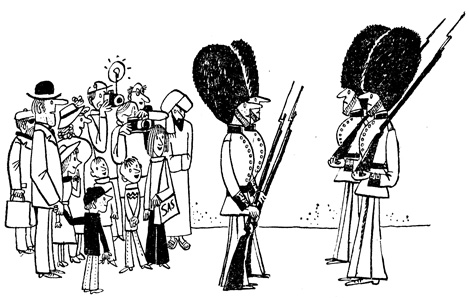
Changing the Guard
One of the most impressive and popular displays of royal pageantry is Changing the Guard, which takes place at Buckingham Palace every day, including Sunday, at 11. 30.
The troops who take part are selected from the five regiments of Foot Guards. Their numbers are dependent on whether the Queen is in residence or not. These form the famous Brigade of Guards, and they consist of the Grenadiers, the Coldstream Guards,* and the Welsh, Irish and Scots Guards.
* (Coldstream Guards - one of the infantry regiments which form the sovereign's personal bodyguard; named after a town in Berwickshire, Scotland.)
The men of the duty guard march from either Wellington or Chelsea Barracks to Buckingham Palace with a band, which during the actual ceremony plays in the forecourt of the Palace.
The guard to be relieved forms at the southern end of the forecourt under the command of the Captain of the Queen's Guard. They are drawn up into two ranks. Before they are stood at ease, the colour is paraded by the ensign on duty. Each regiment has two colours - a royal one and a regimental one. The royal colour can be seen only when the Queen is at home. Sometimes the colour is decorated with a laurel wreath, signifying the anniversary of a battle in which the regiment was engaged.

The new guard enters the forecourt by the north gate. As it approaches, the old guard is called to attention. The new guard is then halted to be formed into files before it advances to position at a slow march. While this is taking place, the band plays. Later the band leads the old guard back to their barracks.
Now a word about the colourful uniforms of the Foot Guards. On ceremonial duty these are scarlet tunics, blue trousers and bearskin caps. Apart from the Scots Guards, the regiments have distinctive plumes. It is easy to identify the different regiments by looking closely at the spacing of their tunic buttons. The oldest regiment, the Grenadier Guards, have singly-spaced buttons; the Coldstream Guards are in groups of two; the Scots, Irish and Welsh Guards in groups of three, four and five respectively.
The history of the Foot Guards goes back to 1656, when Charles II of England, during his exile in Holland, recruited a small body-guard, which was merged in the regiment of guards enrolled at the Restoration in 1660. On St. Valentine's Day, 1661, on Tower Hill,* what had been the Lord General's Regiment of Foot Guards, formed by Oliver Cromwell** in 1650, took up its arms as an "extraordinary guard" for the Sovereign. Having marched from Coldstream, near Berwick-upon-Tweed,*** it acquired the title of the Coldstream Guards. Its motto of nulli secundus**** sufficiently denotes its denial of precedence to the first Guards. The latter acquired their title of Grenadier Guards and their bearskin headdress - later adopted by the rest of the Guards brigade - by virtue of their defeat of Napoleon's grenadier guards at Waterloo.
* (Tower Hill - a hill NW of the Tower where political prisoners were executed until 1747.)
** (Oliver Cromwell (1599-1658) - Lord protector of the Commonwealth of England, Scotland, and Ireland, 1653-1658.)
*** (Berwick-upon-Tweed - the most northerly town in England.)
**** (nulli secundus - (Lat.) second to none.)
In 1661 the Scots Fusilier Guards* became known for the first time as the Scots Guards. In 1707 they were put on the same footing as the other two Guards regiments.
* (Fusilier Guards - an infantry regiment; fusilier - formerly a soldier armed with a fusil (a flint-lock musket), now a historical title borne by a few regiments.)
In 1900 Queen Victoria, pleased with the fighting quality of the Irish regiments in the South African War, commanded the formation of the Irish Guards.
In 1915 the representational nature of the brigade was rounded off by the formation of the Welsh Guards.
The Brigade of Guards serves as a personal bodyguard to the Sovereign.
When the Queen is in residence at Buckingham Palace, there is a guard of four sentries. Only two are on duty when she is away from London.
When the Queen is in residence at Windsor Castle*, another Changing the Guard ceremony takes place in the Quadrangle there at 10 a. m. daily.
* (Windsor Castle - an ancient royal castle, the residence of the English sovereigns, about 22 miles west of London.)
|
ПОИСК:
|
© GENLING.RU, 2001-2021
При использовании материалов сайта активная ссылка обязательна:
http://genling.ru/ 'Общее языкознание'
При использовании материалов сайта активная ссылка обязательна:
http://genling.ru/ 'Общее языкознание'